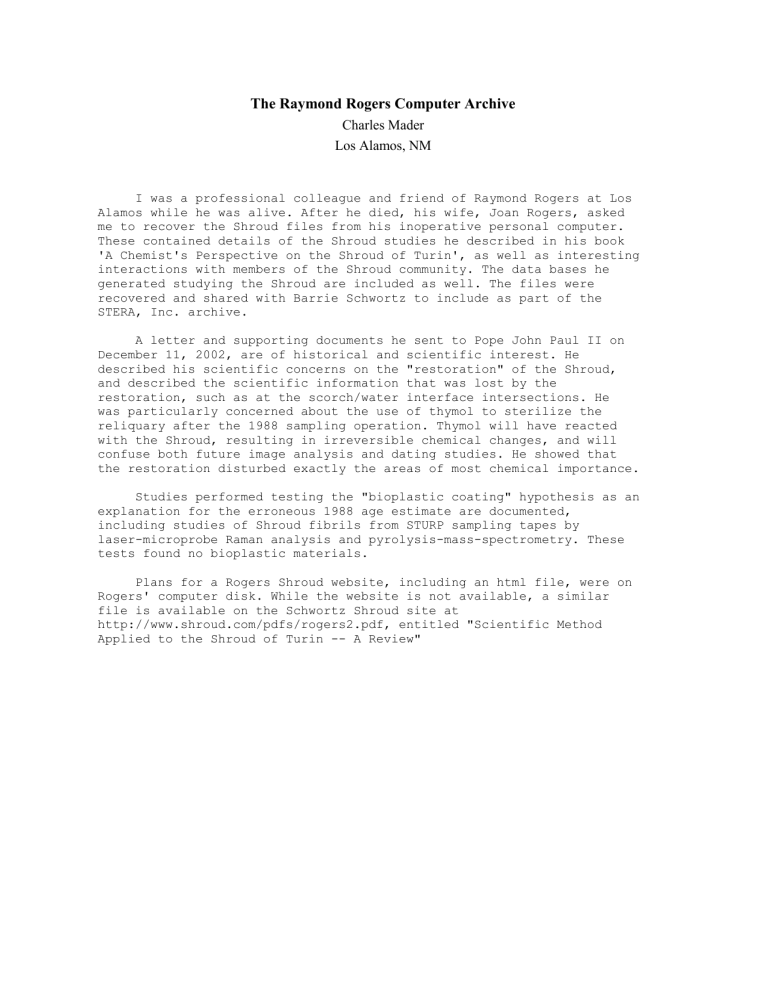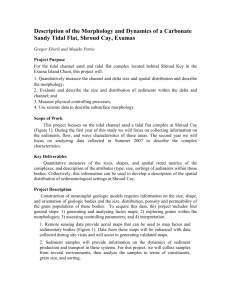Ray Rogers Archive Paper

The Raymond Rogers Computer Archive
Charles Mader
Los Alamos, NM
I was a professional colleague and friend of Raymond Rogers at Los
Alamos while he was alive. After he died, his wife, Joan Rogers, asked me to recover the Shroud files from his inoperative personal computer.
These contained details of the Shroud studies he described in his book
'A Chemist's Perspective on the Shroud of Turin', as well as interesting interactions with members of the Shroud community. The data bases he generated studying the Shroud are included as well. The files were recovered and shared with Barrie Schwortz to include as part of the
STERA, Inc. archive.
A letter and supporting documents he sent to Pope John Paul II on
December 11, 2002, are of historical and scientific interest. He described his scientific concerns on the "restoration" of the Shroud, and described the scientific information that was lost by the restoration, such as at the scorch/water interface intersections. He was particularly concerned about the use of thymol to sterilize the reliquary after the 1988 sampling operation. Thymol will have reacted with the Shroud, resulting in irreversible chemical changes, and will confuse both future image analysis and dating studies. He showed that the restoration disturbed exactly the areas of most chemical importance.
Studies performed testing the "bioplastic coating" hypothesis as an explanation for the erroneous 1988 age estimate are documented, including studies of Shroud fibrils from STURP sampling tapes by laser-microprobe Raman analysis and pyrolysis-mass-spectrometry. These tests found no bioplastic materials.
Plans for a Rogers Shroud website, including an html file, were on
Rogers' computer disk. While the website is not available, a similar file is available on the Schwortz Shroud site at http://www.shroud.com/pdfs/rogers2.pdf, entitled "Scientific Method
Applied to the Shroud of Turin -- A Review"
THE SHROUD OF TURIN: COMMENTS ON THE STATUS OF SHROUD SCIENCE
Raymond N. Rogers
Fellow
University of California, Los Alamos National Laboratory
12 December 2002
I was asked to join the Shroud of Turin Research Project by Fr. Peter Rinaldi during the 1977 United
States Conference of Research on The Shroud of Turin at Albuquerque, NM, USA, in March 1977. I knew that this could be dangerous to my career as a rigorous scientist, and the massive scientific dishonesty I have seen has proved me correct.
During the 1977 Albuquerque conference, I presented information on how existing photographs of the damage from the fire of AD 1532 gave us a large amount of chemical information on the composition of the cloth and image. The information made me doubt that the image was painted, and that made the project interesting. I was subsequently selected to lead the chemical plans section, and I later headed the chemical investigations during the observations in Torino in 1978. I designed the equipment and materials for taking quantitative, non-destructive tape samples from the surface of the Shroud, and I took the samples in Torino. I selected the methods and persons I thought best qualified for making subsequent observations on the tape samples. We assembled and published a mass of objective data.
The persons involved in the restoration of June and July 2002 did not consult any chemists or chemically-oriented textile conservators. The restoration totally destroyed any chemical information as a function of position on the surface that could have been recovered concerning the interactions between reactive
pyrolysis products and Shroud components at the time of the 1532 fire. Any future studies will be much more difficult and expensive: Some will be impossible.
Since the poorly executed radiocarbon sampling in 1988 is what has made the Shroud look like a hoax, the most important thing to do in the future is to obtain a valid radiocarbon age. I have seen a complete lack of understanding of the requirements for scientific sampling, and so much effort has been focussed on hair splitting and sample preparation that the goal of the analysis is obscured. A huge amount of impurity, even containing modern carbon, is required to make the error seen with the 1988 sample. That fact alone should suggest a sampling problem. My advice is to use easily available material that represents an average sample. The scrapings left from the 2002 restoration would make an ideal dating sample, the nonsense about heating effects is pseudoscience, and the scrapings are not now useful for much else. All we need to demonstrate is that the age is much older than that reported in 1989; however, a representative sample will probably date to the First Century.
Aliquots of the scrapings should be sent to several routine dating laboratories without fanfare or pre-treatment.
My wife, Joan, and I did much of the chemical microscopy after returning from Torino in 1978, and she was the person who prepared and hand-carried Shroud-fiber samples to Nebraska and New Jersey for pyrolysismass-spectrometry and laser-microprobe-Raman analyses. Our primary analytical results proved that the
Shroud's image was not a painting.
The Shroud of Turin suggests a large number of questions, and most of the visible ones relate to the chemical composition of the materials. We have assembled information related to the technology of the linen preparation, the probable age of the cloth, the invalid radiocarbon sample that was taken in 1988, the probable mechanism of image formation, and chemical and physical criteria for testing image-formation hypotheses. We are not dedicated Shroud scholars, theologians, or historians, and I believe that our best contribution to Shroud studies has been scientific objectivity and rigor. That has been generally unwelcome.
The truth is neither dangerous nor evil. It can, however, be embarrassing to persons who do incompetent work. I told Fr. Rinaldi and Fr. Otterbein that I would tell nothing but the truth about the Shroud, including any proof that it was a hoax. They were happy with that understanding. Few other church authorities seem to be willing to take the chance on honesty. If scientifically justifiable results are desired from future work, persons with exceptional scientific credentials and ethics should be in charge.
The only reason I returned to Shroud studies was to make critical tests on the ridiculous-appearing hypothesis that the radiocarbon sample of 1988 was invalid. It seemed inconceivable that the sample would not be adequately characterized, but it was not. I still have archived samples that make such tests possible. The
1988 sample was indeed invalid, but the authorities in Torino refuse to discuss the evidence. Unfortunately, I find that the quality of Shroud "science" has deteriorated sadly since the 1988 dating fiasco, and I have been trying to help inject some scientific rigor.
Both Joan and I are retired chemists who worked for the University of California, Los Alamos National
Laboratory. Our primary field of research has been physical chemistry, specializing in the fundamental science of chemical rate processes. Such information is vital to an understanding of image-formation mechanisms and
Shroud conservation; however, the politics and scientific dishonesty surrounding the Shroud make me wonder whether it is worth the effort to pursue Shroud science.
I have been fighting cancer for 17 years, and it is winning. I will not be able to take part in any future studies, so I can be brutally honest. Perhaps that can have a positive effect. I have insufficient stamina and motivation left to fight the stupidity and dishonesty surrounding the Shroud. However, our tests of scientific hypotheses have failed to find any evidence for fraud. Chemical evidence says that it is almost certainly older than claimed and that it is a real shroud. It is a fascinating study, and I wish it could be pursued without all of the concomitant nonsense.
COMMENTS ON THE RESTORATION OF THE SHROUD: A CHEMIST'S PERSPECTIVE
Raymond N. Rogers
Fellow
University of California, Los Alamos National Laboratory
I was asked to join the Shroud of Turin Research Project by Fr. Peter Rinaldi and Fr. Adam Otterbein during the 1977 United States Conference in Albuquerque, NM. During that conference, I presented information on how existing photographs of the damage from the fire of AD 1532 gave us a large amount of chemical information on the composition of the cloth and image [R. N. Rogers, "Chemical Considerations Concerning The
Shroud of Turin," in Kenneth Stevenson (Ed.), 1977 United States Conference of Research on The Shroud of
Turin, 23-24 March 1977, Albuquerque, NM, USA, Holy Shroud Guild, 294 East 150 St., Bronx, N. Y. 10451
(pp. 131-135)] . The information made me doubt that the image was painted, and that made the project interesting.
Although the fire of 1532 nearly destroyed the Shroud, it created opportunities for many types of chemical studies. We would never use the same destructive methods of observation on an undamaged relic, but misadventure gave us many unexpected options. The important fact is that, before the restoration, we could look at the chemistry of specific locations on the Shroud where scorches intersected image, blood, serum, and water stains. The restoration destroyed much chemical information at those intersections.
If the image had been painted or retouched, some foreign materials had to be added to the cloth. The pigments and vehicles (e.g., the ochers, realgar, orpiment, mosaic gold, glair, gums, and glues) would have been subjected to a violent "chemical test" during the fire. The temperatures, temperature gradients, pyrolysis products, and water used to extinguish the fire would have changed the chemical composition of most foreign materials. Before going to Turin in 1978, we did many experiments on the stability of the painting materials.
We had hoped that future observations on the Shroud could compare predictions with reality. The restoration disturbed exactly the areas of most chemical importance.
I was subsequently selected to lead the chemical plans section for STURP, and I later headed the chemical investigations during the observations in Torino in 1978. I designed the equipment and materials for taking quantitative, non-destructive tape samples from the surface of the Shroud, and I took the samples in
Torino. I selected the methods and persons I thought best qualified for making subsequent observations on the tape samples. We assembled and published a mass of objective data [for example, L. A. Schwalbe and R. N.
Rogers, "Physics and Chemistry of the Shroud of Turin, a Summary of the 1978 Investigations," Analytica
Chimica Acta 135 (1982), pp.3-49, a peer-reviewed article.]. We proved that the image was not painted. After my initial work, I sent Prof. Alan Adler most of my samples for additional studies.
I had planned to use the tape samples for studies for many years. After Al Adler's death, Jean Adler sent them to Torino without contacting me. No person in Torino will respond to questions about the location and condition of the samples. Since they were sent to Torino, no scientific reports have appeared that used them as originally intended. This is a great loss, especially since the restoration.
.The persons involved in the restoration of June and July 2002 did not appear to be familiar with previous scientific observations, and they did not consult chemists with different areas of experience or chemically-oriented textile conservators. The restoration destroyed much of the chemical information that could have been recovered as a function of position on the surface of the Shroud.
The fire of 1532 produced many extremely reactive pyrolysis products, and the fire was extinguished with water. All paints that were used during or before Medieval times are changed by heat and/or the chemically reducing and reactive pyrolysis products of the cloth (e.g., formaldehyde, furfural, organic acids, CO, etc.). For example, red hematite would have been reduced to black magnetite. This fact provided one basis for refuting
McCrone's claim that the image was painted with hematite. We planned to look for the products of such reactions. Some Medieval painting materials become water soluble, and they would have moved with the water.
A huge amount of chemical information existed in the scorches.
Most organic colors are much less stable than cellulose (linen) and the normal inorganic pigments.
Experiments in 1978 showed that scorch lines in impurities precede the scorches in pure linen. Most organic
materials, including natural products, change in predictable ways in response to heating and the known products of cellulose pyrolysis. We even tested squid ink, which had been reported being used in ancient times.
It might still be possible to extract the products of the reactions from the materials recovered during the restoration, assuming that samples were segregated and locations were recorded. Such information could be important for suggesting the chemical composition of the image. Most possibilities for directly studying the effects of the fire on image materials were destroyed by the restoration of 2002.
Visual and microscopic observations on the Shroud in 1978 indicated that image color or its reaction products did not move with the water. Other unidentified products did move. Aldo Guerreschi has recently suggested that two different sets of water stains exist on the Shroud. They could contain interesting chemical and historical information. We had counted on the tape samples and possible future direct studies on the scorch/water-stain areas of the Shroud for detailed chemical confirmation of what did and did not move with the water. Now both the tape samples and scorches are gone.
The Shroud showed many locations where scorches of different severity intersected image and/or blood.
Thermal gradients can be estimated on the basis of scorch colors. Temperatures are the most important factors in calculating chemical rates. We made predictions on the kinds of products that might appear in image areas as a result of reactions between its components and the pyrolysis products and water. These predictions could be used to test all of the hypotheses that had been proposed for image formation.
I took samples from many scorch/water/image intersections in 1978, but observations on them generated more questions. Answers required additional observations and/or samples. The samples are now secreted in
Torino. As a result of the restoration, any future studies will be much more difficult and expensive: Some will be impossible.
The Shroud is a structure composed of chemical compounds, and all of the main ones have been studied in detail. Chemical analyses can yield considerable definitive historical information. All manipulations of the
Shroud should be considered in detail in order to preserve as much information as possible.
Linen-production technology has changed through the centuries. We have assembled chemical information related to the technology, and we have consulted textile experts who have done detailed chemical research that relates to the composition of the Shroud. Our detailed analyses suggested that the cloth had been prepared by technology common before about AD 1200. It best resembles linen made during Roman times.
These results do not agree with the date published in 1989, and the difference remains to be resolved. Samples from the restoration might help resolve the dating problem, but they require communications with the Shroud's custodians in Torino. No scientist in Torino will discuss the problem, and the custodians refuse to recognize the problem.
Lignin is a structural polymer that is found in all plants, including flax. Linen is bleached in an effort to remove as much lignin as possible, but some lignin always remains in linen. Lignin slowly ages with the loss of vanillin (4-hydroxy-2-methoxybenzaldehyde). A very sensitive microchemical test exists for the detection of traces of vanillin. It is easy to detect vanillin in the lignin of modern linen, it is harder to find in Medieval linen, and no test can be obtained from the few Shroud fibers that are still available for study. This observation would suggest that the linen of the Shroud is very old, casting doubt on the accuracy of the 1988 date.
I made kinetics measurements on the rate of aging of lignin for STURP in 1979. Chemical rates of all kinds of reactions are modeled with an exponential equation called the Arrhenius expression, and rates depend very strongly on temperature. k = Ze -E/RT
The rates can be predicted from known, measured chemical kinetics constants (k, the rate constant; Z, the
Arrhenius frequency factor; E, the Arrhenius activation energy; R, the gas constant; and T, the absolute temperature in degrees Kelvin). Any chemical process involved in Shroud aging or image formation will have properties in accordance with this equation.
The rates of lignin degradation were extremely slow; therefore, we used the time until the phloroglucinol/HCl test failed to detect lignin. This required measurements after 24 months of constant heating.
The equation I derived is the following: k
3 .
7 x 10
11 e
29 , 600
1 .
987 T
The numbers determined for lignin lie within the range of expected values, and they are close to those for the first dehydration reaction of cellulose (about 29,000 cal/mol).
Cellulose starts to color rapidly at about 325ºC. That should be close to the temperature at the margins of the scorches during the fire of 1532. At that temperature, it would require about 0.6 second to decompose
95% of the lignin. Since the rate law is exponential, the time required increases greatly as the temperature decreases. For example, if the Shroud had been stored at 25ºC, it would have required about 1,319 years to evolve 95% of the vanillin. A lower temperature would have required much longer.
In the context of lignin aging, information on temperature gradients at the time of the fire could enable chemical-rate estimates. The restoration truncates and confuses any such study at linen/scorch intersections.
However, the absence of a lignin test on the Shroud indicates a greater age than reported in 1989.
The tape samples show that much of the charred material is elemental carbon. It is very inert chemically. It would not have changed during the 470 years since the fire. Published concerns about isotope fractionation during the fire are nonsense. I have long used kinetic-isotope effects in my professional career.
The carbonized material can easily be chemically cleaned of any organic deposits that might have appeared after the fire, making it an ideal material for radiocarbon dating. Before the restoration, the carbon from specific areas could have been dated separately, giving critical information about the homogeneity of the cloth as well as "clusters" of dates. Clusters of dates are more reliable than dates on single samples.
Biblical accounts suggested several types of compounds that might have appeared on the cloth (e.g., aloes, myrrh, sebaceous secretions, etc.). We planned and executed chemical analytical methods that could detect them in 1978. Those methods were extremely sensitive, but they did not detect squalene or myrrh. The analyses did suggest some image-formation hypotheses.
The surface of the Shroud could have been analyzed by Electron Spectroscopy for Chemical Analysis
(ESCA), which observes the top few nanometers of the surface. Now that the surface has been disturbed, that powerful technique will be much more difficult to apply, and results will be ambiguous. This is a terrible, discouraging loss for Shroud chemists.
The problems associated with surface analyses are now compounded by the fact that thymol was used to sterilize the reliquary after the 1988 sampling operation. Thymol is a phenolic compound that will react with many functional groups on the Shroud. This will confuse image analyses, and it may result in damage to the cloth. As one example, we found a significant amount of iron in the Shroud's cloth. Iron reacts with phenolic compounds to form complexes, and some of them are intensely colored. I would urge the custodians of the
Shroud to consult with chemists before taking other irreversible actions.
One justification for the hurried, secretive restoration was a fear of "autocatalytic" degradation of the cloth. No experts on chemical kinetics were consulted. The Shroud has not been and is not now in danger of autocatalytic degradation.
Autocatalytic chemical reactions are those in which the rate increases as the amounts of reactants decrease, i.e., while the materials are reacting. The most important single factor in predicting effects is the temperature . When the temperature changes, the rate changes. The only severe heating episode the Shroud has suffered was during the fire of 1532. Any autocatalytic decomposition that occurred then has long since stopped as the Shroud is stored at normal temperatures.
Autocatalysis can not rigorously be discussed without some reference to basic chemical kinetics and mathematics. The fundamental equation that describes an autocatalytic process is the following: d
k
p
1
q
Ze
E
RT dt where
is the fraction reacted at any specific time, t. The derivative, d
dt, is the rate of the reaction, E is the activation energy, and Z is the pre-exponential. Each applies only to a single specific, consistent reaction being studied. The value of the rate constant is different at each specific temperature: It is a constant only at one temperature, and it applies only to one specific reaction. The values of E and Z are determined from a large number of k measurements at different temperatures.. Predictions of the Shroud's expected lifetime can not be made on the basis of a single rate constant. Observations made during a scorching event can not be applied to rates at normal temperatures.
Examples of simple and autocatalytic rate curves are shown in the figure. Notice that the rate increases with time in the autocatalytic curve, at constant temperature , until it reaches a maximum reaction rate. Then the rate decreases. However, the initial rate at any temperature is much lower than the maximum rate.
The chemical decomposition rate of cellulose is essentially zero at room temperature.
When cellulose is decomposing autocatalytically at high temperature, the rate can be returned to its initial value by cooling.
The activation energy, E, is closely related to the strength of the reacting chemical bond. Strong bonds show high activation energies when they react; weaker bonds show lower activation energies. The bond that breaks at the highest rate in the initial pyrolysis of cellulose is the C-OH bond on the hydroxymethyl functional group of the sugar units that make up the cellulose polymeric chains. That bond has an energy on the order of 80 kcal/mole. It is not a weak bond.
Activation energies in solids, especially crystalline solids like cellulose, are higher than the values for the same material in a solution or melt, because a crystalline lattice is stabilized by its ordered structure.
Cellulose is composed of very long polymer chains of sugar molecules. The chains are folded back and forth in a regular pattern that shows the properties of crystallinity. It is called a "fibrillar structure" in materials like linen.
The major cause for autocatalysis in cellulose decomposition is the destruction of crystalline order when the material is heated to a high temperature. This kind of autocatalysis involves a process called "melting with decomposition." Melted materials decompose more rapidly than the same material in a solid phase [Rogers, R.
N., "Differential Scanning Calorimetric Determination of Kinetics Constants of Systems that Melt with
Decomposition," Thermochimica Acta 3, 437 (1972)]. When the material is cooled below the melting point, autocatalysis stops.
The decomposition rate of a crystalline solid depends on crystal perfection. When crystals are put under stress, they develop high-free-energy defects, and decomposition is much faster at the defects than it is in the parent material. If autocatalysis were a real problem for the Shroud, significant differences should have been observed in damage around the stressed and strained stitching of the patches. There is no sign of accelerated degradation, indeed there is no sign of any autocatalysis on the Shroud.
The structure of pure, uncatalyzed, crystalline cellulose does not begin to dehydrate at a significant rate until about 300
C [R. N. Rogers, A Compilation of DTA and Pyrolysis Curves , GMX-2-R-61-1, 1 March 1961, Published by the Los Alamos Scientific Laboratory, Los Alamos, NM, USA]. A knowledge of cellulose kinetics enables some estimation of temperature gradients during the fire of 1532. This would have been important information before the surface was disturbed.
Some reactions involve chemical autocatalytic rate processes in which a product (or products) of the primary reaction is a catalyst for the reaction (or causes the material to melt): The rate increases as catalytic products accumulate. Small changes in the composition of the reacting material can have very large effects on the values of E and Z, as in any case of catalysis. If the process is cooled, the rate will be much lower, depending on phase changes, the magnitude of E, and retention of the catalytic product(s).
The possibility for chemical autocatalysis in linen depends on the products of cellulose decomposition.
Feigl and Anger [Feigl, F. and Anger, V., 1966, Spot Tests in Organic Analysis, Elsevier Pub. Co., New York.] described the effects of heating cellulose as follows: "When cellulose is heated it decomposes and the resulting
superheated steam reacts with unchanged cellulose to produce hexoses, which in turn hydrolyze to give hydroxymethylfurfural." The only important chemical catalyst for the autocatalytic degradation of cellulose at high temperatures is superheated steam. Superheated steam does not exist at normal temperatures, and the only important autocatalytic process in cellulose stops until another heating episode. There is no "memory effect."
The Shroud is as stable at room temperature as any other sample of linen.
More detailed studies have shown that the major secondary products of the thermal decomposition of cellulose are formaldehyde, furfural (2-furaldehyde), hydroxymethylfurfural (5-hydroxymethyl-2-furaldehyde), levulinic acid (4-oxopentanoic acid), and 3-pentenoic-
-anhydride. None of these is a significant catalyst for the autocatalytic decomposition of linen. Indeed, formaldehyde, furfural, and hydroxymethylfurfural are reducing agents, antioxidants. Furfural inhibits the growth of molds and yeasts. Scorched areas are less likely to show microbiological attack.
I measured activation energies and decomposition mechanisms for the individual decomposition products of several carbohydrates [Rogers, R. N. and Smith, L. C., 1970, "Application of Combined Pyrolysis - TLC to the
Study of Chemical Kinetics," J. Chromatog. 48 , 268]. These measurements included the rapid, catalyzed decomposition of levulose. The sugar units in linen are glucose, a similar hexose. It was catalyzed with concentrated phosphoric acid, a nonvolatile, strong, inorganic acid. It would be hard to find a more rapid decomposition of the kinds of molecules seen in cellulose. The most important observation was that no condensable products appear below about 135
C.
This kind of catalyzed reaction is similar to that responsible for the destruction of books that are made with cheap, acid paper. Claiming analogy between such books and the Shroud is mischievous. Adler and Schwalbe made the following comment: "Previous chemical reactions on the cloth, e.g., the retting process in manufacture of the linen, the known historic fire and its extinguishment, and previous display and storage procedures, have left a variety of chemical structures on the surface that can act as oxidants and also as catalysts. For example, the acidic structures produced by previous oxidative activity can strongly promote various types of autocatalysis" [A.
D. Adler and L. A. Schwalbe, "Conservation of the Shroud of Turin," Shroud Spectrum International, No. 42,
December 1993, Indiana Center for Shroud Studies]. Such spurious, unreviewed claims may have led to the restoration.
I have not been able to observe any chemical autocatalysis in cellulose at normal temperatures. Observations and descriptions of the Shroud through the 470 years since the fire of 1532 do not support fear of catastrophic decomposition of the cloth; however, if Shroud deterioration is still a worry, one practical way to slow the rate is to keep it cold. That also has the advantage of reducing microbiological attack. As in the case of the use of "inert" atmospheres (which should not include thymol), storage at reduced temperature should carefully be considered. Too low a temperature could cause physical stress and might cause fibers to fracture. It would probably cause the thin coating of image color on the fibers to be loosened in some areas. Competent scientific textile conservators should be consulted before the Shroud is cooled.
As a rule of thumb according to the Arrhenius expression, rates of normal reactions are increased by a factor between two and three for each 10
C increase in temperature. The effect is much larger when a phase change is involved, e.g., melting. Some moderate cooling could have a useful effect on prolonging the life of the Shroud.
Severe freezing could damage the cloth and image.
Summary:
A knowledge of chemical kinetics would have eliminated fears about autocatalytic degradation of the Shroud.
There was no danger.
The restoration severely damaged areas that were critical to obtaining a detailed understanding of the composition of the image and hypothetical image-formation mechanisms.
Rates of vanillin evolution have been measured for lignin. Microchemical tests on samples that were taken in
1978 failed to detect lignin on Shroud fibers. The results indicate a much older cloth than claimed as a result of a radiocarbon analysis in 1988. The conflict should be resolved.
Careful separation of the components of the materials recovered from the restoration could provide an excellent set of samples for radiocarbon age determination. Carbonized cellulose removed from the scorch areas can be partially separated by floatation and quantitatively cleaned chemically. It might be possible to obtain a cluster of ages, an important feature.
The 2002 restoration of the Shroud of Turin illustrates the danger of secretive, precipitate actions.
SUDARIUM, OLD LINENS, HOLLAND CLOTH FROM AM*STAR (12/11/04-1/10/05)
0) "Holland cloth" weft, sent to me (R. Rogers) by Tom D'Muhala of AM*STAR. 300X, Polarized, in 1.515 oil.
Did not study intensively, but I did not detect any flax in the sample. All of the fibers appear to be cotton. The sample seemed to be too imperfect to measure an n
D
.
1) Warp, same conditions as weft. The fiber does not go to extinction in any orientation. It looks like cotton, but pseudomorphs or mercerized? Some is as wide as 30 micrometers. Shows many twists (more modern - or processed) cotton? Do not have enough experience with cotton to make definite statements.
The Holland cloth samples I took in 1978 have much the same appearance, although I never did a concerted study. The photomicrograph shows fibers from 1FH (near the Raes/radiocarbon area) from the Holland cloth.
One normal flax fiber is visible, but the other has the same properties as the AM*STAR samples.
2) 2000 BC linen from a mummy wrapping, sent by Fr. Manny Carriero, Madrid. It has a light-brown color, is a Z twist, and fibers are about 13 micrometers dia. on average. Patches of crust, possibly microbiological, can be seen with a hand lens. 400X, 1.515 oil, no pols. Can see patches of crusty material and the light-brown color.
Lots of particulates.
3) Same 800X. Can not see lignin at nodes. The medullas look very peculiar (see below - the ultimate-cell "fuzz" seems to have been turned into "goo."
4) Same 800X, POLS with conical lighting (0.85 NA). There are lots of defects and other signs of aging. I am surprised how little background birefringence appears. Most of the defects seem to penetrate the entire fiber and look like p+, but the tracks are quite clear and easy to see. I am surprised that some younger samples seem to have a higher defect population.
5) Same with parallel illumination. Not so much scattered light from the internal structure.
6) SUDARIUM OF OVIEDO: Could see one blue cotton fiber in the view. 100X, 1.515 oil, no pols. Can see lignin at most/many nodes. Looks very much like Shroud fibers .
7) Same 800X, no pols, parallel illumination. Can see rather heavy deposits of lignin at nodes.
8) Sudarium fibers at 800X POLARIZED. Spots of opaque lignin at nodes. Bright bands are the very birefringent nodes, but there are many defects that increase birefringence. NOTE THAT THERE ARE ALSO "DARK
DEFECTS." My current hypothesis for them is that, given time, ion tracks "anneal" (not in the same sense as inorganic crystals), leaving dark voids. This needs to be tested with known samples on the hot stage. Defect energies could be measured, as well as kinetics constants for annealing.
9) Same with conical illumination - poor focus. Notice that the defects cross the fiber at different angles (all stress dislocations are at the same angle).
Other Sudarium fibers polarized, 800X, with conical illumination. Lots of defects, but surprisingly little haze.
The dark defects do not show up as well with conical light.
While looking at Sudarium samples, I noticed that at least some of the alpha tracks (what I am calling the very short, brightly birefringent ion tracks) changed with stage rotation. For example, they could be very birefringent when across the N-S orientation of the plane of polarization and yet nearly disappear when they were across the
E-W orientation. This effect was visible only with parallel illumination: the defects can be seen in all orientations with conical illumination. Most "alpha tracks" seemed to be about 2.6 micrometers long, BUT remember that is the birefringence caused by strains in the crystals. It does not represent the actual track of the particle.
10) MODERN LINEN. A modern fiber at extinction. There was much stress twinning from machine spinning and weaving. There were even some dark defects. Had the sample been washed and ironed repeatedly? If it had been put out to dry in the sun, that could explain the background birefringence (like medieval bleaching effects).
11) Some dark tracks/defects 800X, parallel illumination, polarized.
12) 2000 BC linen. There is appreciable crust, and the MEDULLA IS ROTTEN. Many defects could be seen, both dark and bright, when it was polarized (next roll of film). 800C, conical. The medulla is much better observed by parallel illumination (next roll).
Hypothesis: Fresh defects are birefringent because of crystal strains: the ionizing radiation causes imperfections as it passes through the low-lattice-energy organic crystal. Many free radicals would be produced, and many of them would be trapped in the lattice. The strains and concentrations of free radicals would be high-free-energy zones: they would react more rapidly than unaffected crystals. The most probable reactions would be dehydration and cross-linking. These reactions would relieve strains, but decomposition reactions would leave voids. Radiation would weaken the fibers and leave "dark defects."
Raymond Roger’s CONCLUSIONS
After 25 years of scientific study, I believe that three statements can be supported on the basis of established laws of science and direct observations on the Shroud of Turin.
1. The radiocarbon age determination made in 1988 used an invalid sample, and it gave an erroneous date for the production of the main part of the cloth.
2. The hypotheses that have appeared since the announcement of an AD 1260-1390 date that invoke radiation of different kinds to explain the image and the date can be categorically discarded.
3. The characteristics of the image can be explained by reference to highly probable, well-known chemical reactions. No miracles are necessary to explain the image.
The Raymond Rogers Computer Archive paper, PowerPoint, and Lecture is available in the
Shroud Directory of the Cloud Archive at
http://is.gd/4NnP1Z






